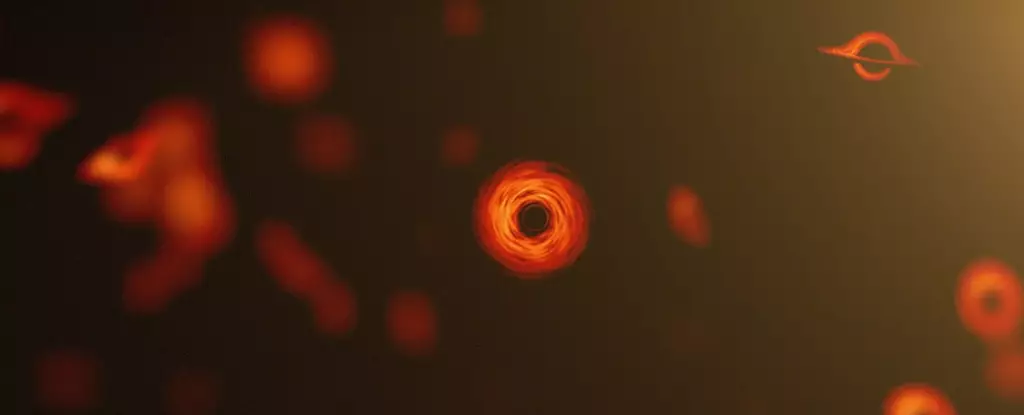In the realm of astrophysics, few topics garner as much intrigue and speculation as that of primordial black holes (PBHs). These hypothetical entities, theorized to have formed in the very early universe, represent a conundrum that straddles the line between established science and speculative theory. Their possible origins—subatomic particles collapsing under their own gravity during the tumultuous aftermath of the Big Bang—pose significant implications not only for our understanding of black holes but also for dark matter, gravitational waves, and many unresolved cosmological puzzles. However, the lack of direct observational evidence has left researchers floundering in the turbulent waters of theoretical physics, eager for concrete discoveries that lend credence to these ancient cosmic phenomena.
Among the various hypotheses surrounding dark matter candidates, PBHs have resurfaced as particularly compelling. They offer a potential resolution to age-old cosmological questions regarding the nature and distribution of dark matter. Unlike conventional black holes formed from stellar collapse, PBHs represent a unique class that may have formed through entirely different mechanisms. Their small size and relative abundance could help account for discrepancies in our current understanding of the universe’s mass-energy balance. But the tantalizing question remains—how can we unearth these elusive remnants from the dawn of time?
Recent Research: A New Strategy for Detection
Recent advancements in this field have animated discussions about the possible detection of PBHs. A significant breakthrough emerged from a collaborative effort led by physicists De-Chang Dai and Dejan Stojkovic, who proposed novel methods for searching for evidence of these primordial entities. Their research posits that PBHs could be lurking within celestial bodies such as asteroids, planets, or moons. Specifically, they hypothesize that a PBH positioned within a solid crust surrounding a liquid core would consume the surrounding material over time, potentially leading to the formation of a hollow interior, effectively hiding in plain sight.
These ideas hinge on the material strength of the planet’s crust, which might endure the gravitational stress imposed by a small black hole. Their calculations revealed that materials like granite could support hollow structures significantly within the earth’s dimensions. Thus, the researchers argue for a refined approach to the investigation of planetoids and other celestial bodies, suggesting that assessing their mass and density could yield crucial clues about the presence of PBHs.
The duo of Dai and Stojkovic has outlined practical experimental frameworks designed to test their theories. One exciting method involves creating large plates of polished metal or utilizing existing natural materials on Earth to detect micro-tunnels purportedly left by PBHs. The gravitational sectors of these microscale objects can leave traces in solid media as they traverse through matter, a phenomenon that could perhaps be monitored more effectively in prepared environments.
Considerable attention has been paid to the scale of these tunnels; a small PBH could theoretically carve a pathway through materials without disturbing the macro structure significantly. If the predicted energies were absorbed by the surrounding matter, the discernible shifts in material characteristics could serve as an indicator of a PBH’s presence.
The Road Ahead: Implications of Findings
The potential ramifications of successfully identifying PBHs within our universe extend far beyond the black holes themselves. Their discovery could reshape our understanding of dark matter, shedding light on a pivotal component of the cosmological model. Moreover, the existence of PBHs could help unravel other mysteries tied to gravitational waves, dynamic structures within galaxies, and cosmic evolution itself.
While some may express skepticism regarding the bounty of rewards from these ambitious pursuits, the researchers maintain that the low cost of conducting these experiments may yield unexpected dividends. Even if the expected yield of PBH detection remains low, the sheer scale of implications from a positive outcome could redefine paradigms in astrophysics.
While the research led by Dai and Stojkovic illuminates a path forward in the quest for understanding primordial black holes, it also invites broader discourse within the scientific community. The notion that black holes could escape traditional confines and find refuge in familiar celestial structures reignites the vigor with which we should approach cosmological exploration. Going beyond mere speculation, the proposed methodologies pave a potential roadmap to uncovering the remnants of the universe’s infancy. As the story of PBHs continues to unfold, it holds the promise of unveiling some of the most profound truths about our universe and the dark matter that dances just beyond the veil of our perception.

